The final match of Group F saw Portugal snatch victory at the death against a courageous Czechia side defined by unfortunate errors.
Roberto Martínez’s substitutes were the critical catalyst for Portugal’s winner, with Francisco Conceição guiding the ball past Stanek in second-half stoppage time and Pedro Neto’s energetic dribbling providing the spark, which had been missing in the final third all game.
Despite the fact that Portugal emerged victorious in Leipzig, the scoreline merely masked clear attacking deficiencies for the majority of Portuguese fans, with their attacking performance wildly different from their dominance in the qualifying phase.
For all the attacking talent that Portugal hold within their squad, we saw a tournament-high 31 crosses with just 32.26% accuracy overall.
This suggests that Portugal’s strategy in the final third was down to necessity and not a preconceived plan.
It represented an overall laboured performance from the Portugal attackers, who were unable to effectively penetrate Czech Republic’s resolute low block despite having over 73% of overall ball possession.
In this Portugal vs Czechia tactical analysis, we will highlight why their attacking approach was mostly fruitless, with Portugal relying on Czechia’s defensive mistakes to find all three points.
Our analysis will also look to understand how Roberto Martínez’s Portugal starting 11 Euro 2024 squad will fare in their next group encounter with Türkiye, with Vincenzo Montella’s defensive tactics contributing to a nerve-wracking victory over tournament debutants Georgia.
Portugal’s tactical setup
From the outset, Portugal opted for the back five that had been experimented with in the lead-up to the tournament, potentially looking to match the Czech formation.
However, Roberto Martínez’s starting selection saw three full-backs start the match, with Cancelo and Dalot on the left and right flanks, respectively, and Nuno Mendes deployed as the left-sided central defender.
This left a midfield pairing of Vitinha and Bruno Fernandes behind an attacking trio of Rafael Leão, Bernardo Silva and the main striking outlet of Cristiano Ronaldo.
João Cancelo’s positioning was particularly interesting, opting for more of an inverted midfield role to create more ball dominance in the middle third.
It can be theorised that this could have been responsible for a lack of Portuguese invention on the left wing, with Leão often isolated and unable to create additional inventive play with an overlapping wing-back.
Nuno Mendes was unable to attack as frequently due to the defensive vulnerability this would create in his absence.
Bernardo Silva was often seen inverting from the right flank, almost operating as a shadow striker at times in close proximity to Ronaldo, allowing Dalot to advance into the vacated space on the wing.
But for all of Portugal’s tactical dynamism and players interchanging the Czech resistance was unfazed and only led to Portuguese confusion when trying to find the back of the net.
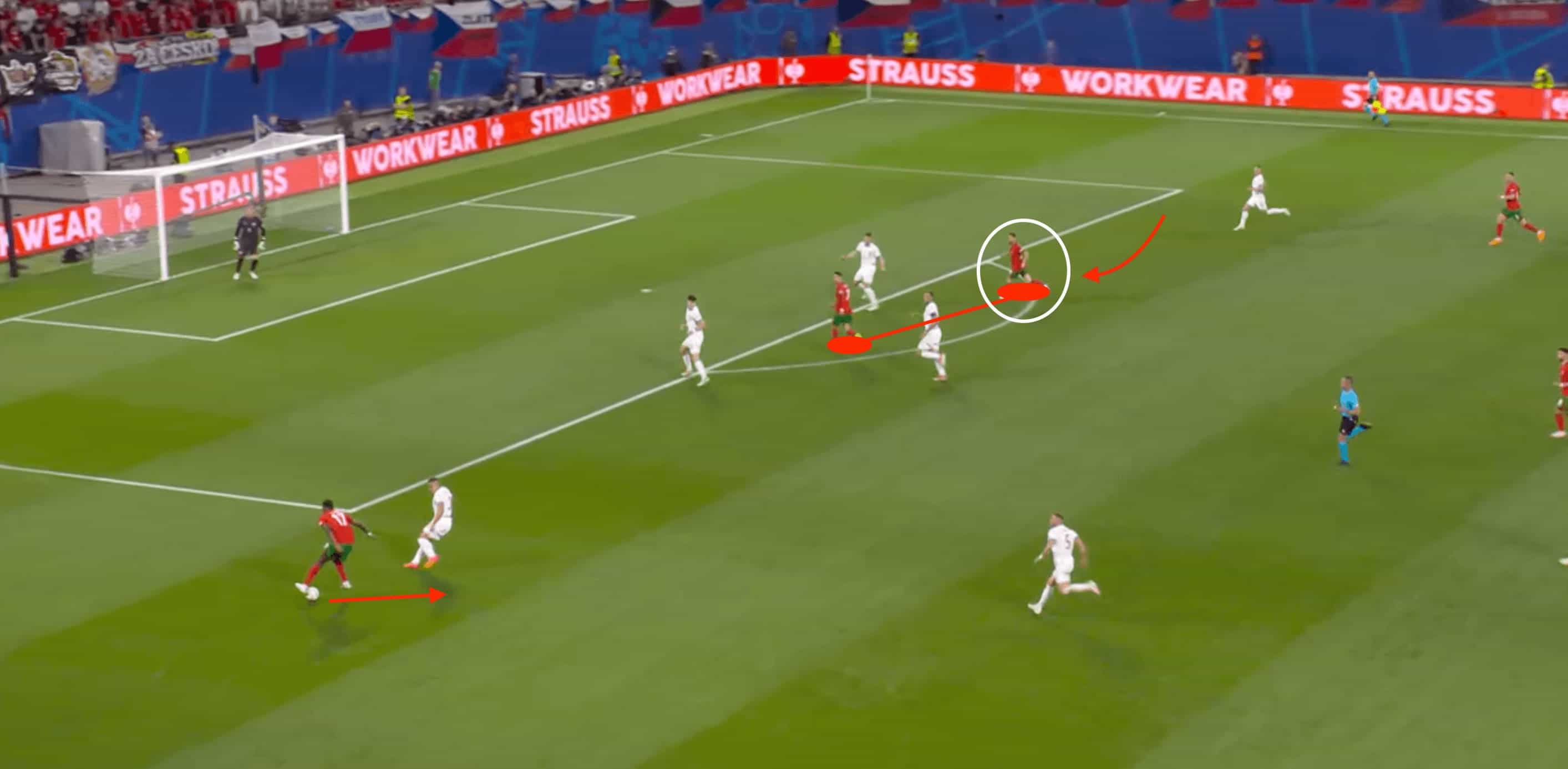
Laboured Portuguese attack
In our EURO 2024 preview for Portugal, we highlighted the fact that their attacking fluidity and intelligent movement were key factors in unlocking opposition defences, especially utilising the deeper movement of Ronaldo to create space to attack in behind.
Portugal targeted this early on in the match, but the depth of the Czechia defensive line and numerical superiority in the final third proved to stifle any inventive play from Portugal.
On this occasion, we saw Ronaldo drop deeper to draw a defender out, while Bernardo Silva offered an excellent passing outlet with his run across the face of the penalty area, forcing Souček to be reactive in his defensive assignment.
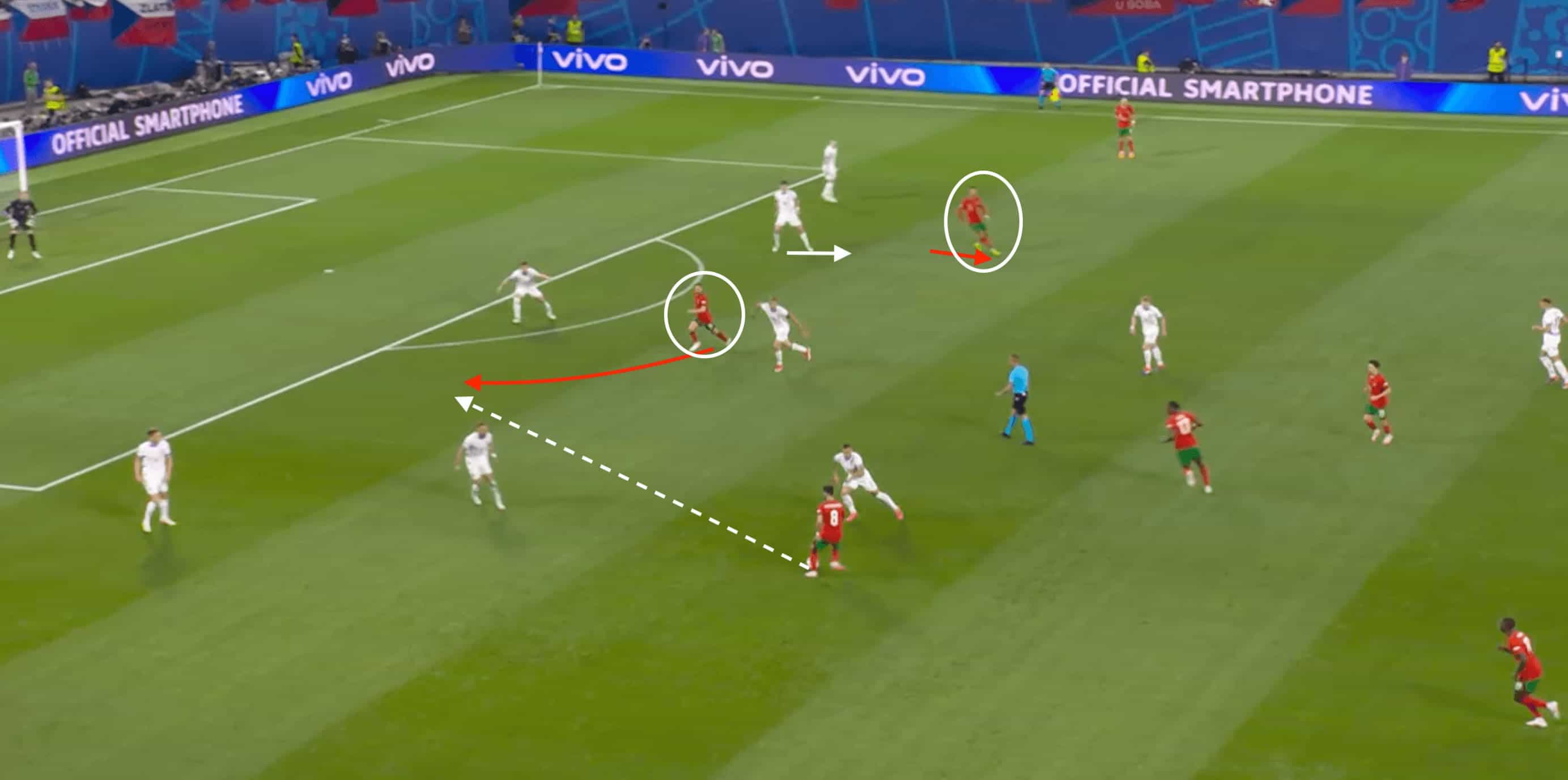
In spite of his impressive run, Silva’s return pass failed to create a favourable opportunity, as there was a lack of offensive presence in the Czechia penalty area.
Ronaldo was still trailing after creating the initial space.
Credit must be given to the Czech defensive line, which was physically determined and forced the Manchester City midfielder into a rushed decision.
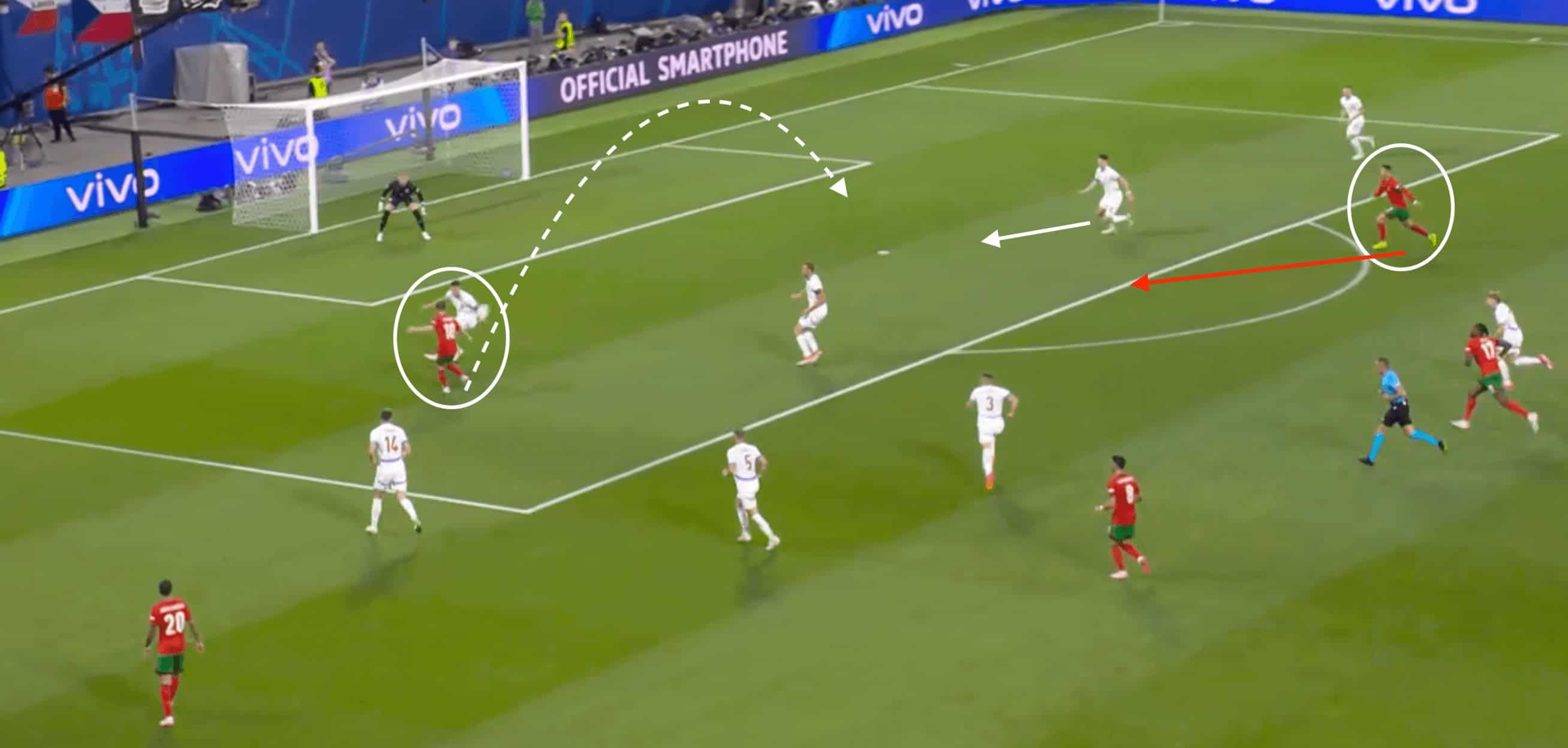
Ivan Hasek’s Czechia side provided a gritty, mature defensive showing despite their relative inexperience on the international stage.
Their five-man defensive low block allowed Portugal to dominate possession but crucially only really allowed lateral passes and the aforementioned hopeful crosses.
Significantly, when Tomáš Souček could drop in from the base of midfield, the superior number of Czech defenders were often able to easily cut out any type of delivery into the box.
Their compact shape meant that space was minimised in the central areas, forcing Portugal to maintain its width with Leao and Dalot and constantly look for their key aerial threat of Ronaldo.
This was evident when looking at their possession in each attacking channel, with 43.1% on the left wing and 34.2% on the right.
Even though he has been historically impressive when playing as the lone outlet, Ronaldo struggled to evade the heightened defensive attention, often doubled up on, but also fairly static in his movement.
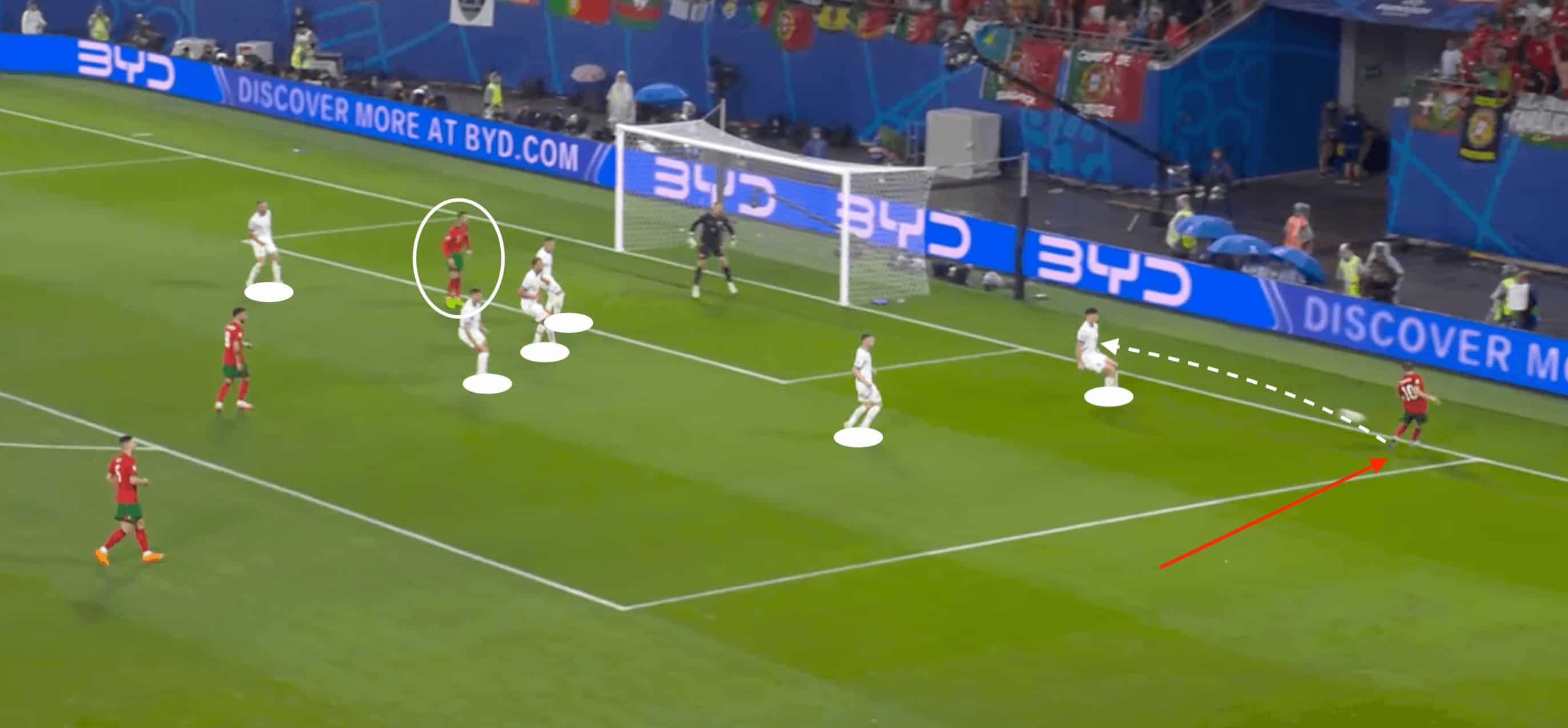
The moment in which Portugal’s attacking cohesion finally clicked was after some key substitutions which provided more attacking threat within the penalty area.
Martinez decided to switch Leão for Diogo Jota and Dalot for Gonçalo Inácio, forcing Cancelo over to the right wing and freeing up Nuno Mendes to advance further on the left flank.
Portugal targeted crosses from the top of the box as opposed to from the byline, looking to find space and gaps to exploit once the Czech defenders would step out, and Vitinha’s ball found the head of Mendes to force the own goal.
The critical element of this attacking move was the runs of both Ronaldo and Jota, who darted forward to create the 1v1 for Mendes at the back post, finally displaying the attacking intelligence many had expected from Portugal.
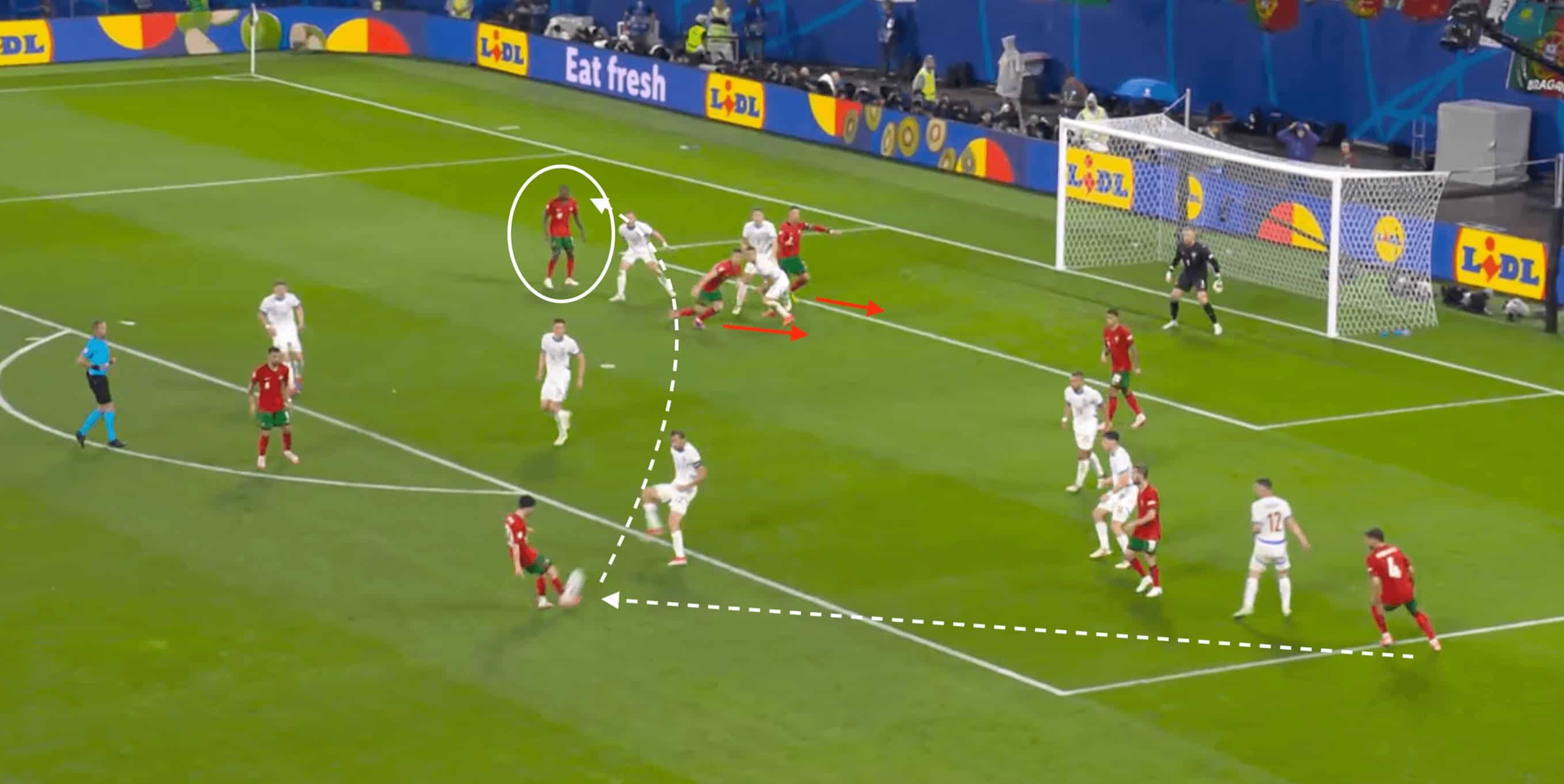
Targeting the Turkish defence
Dortmund played host to the other match in Portugal’s group, producing a fascinating encounter between Türkiye and Georgia.
Of particular interest to Roberto Martínez will be Türkiye’s defensive shape and the ways in which Georgia were able to hurt their opponent in an end-to-end affair.
When analysing the match, it would appear as though whilst Portugal were unable to unlock the Czech defence with their cross-heavy approach, it may prove to be much more profitable against Türkiye.
In their first match at a major tournament, Georgia found success from the flanks against the Turkish defence.
Napoli starlet Khvicha Kvaratskhelia found plenty of space for progressive carries, boasting the game’s largest expected threat (xT) statistic of 0.57.
Georgia’s methodical build-up often culminated in crossing opportunities, with Türkiye often failing to track late runners from midfield arriving into the penalty area.
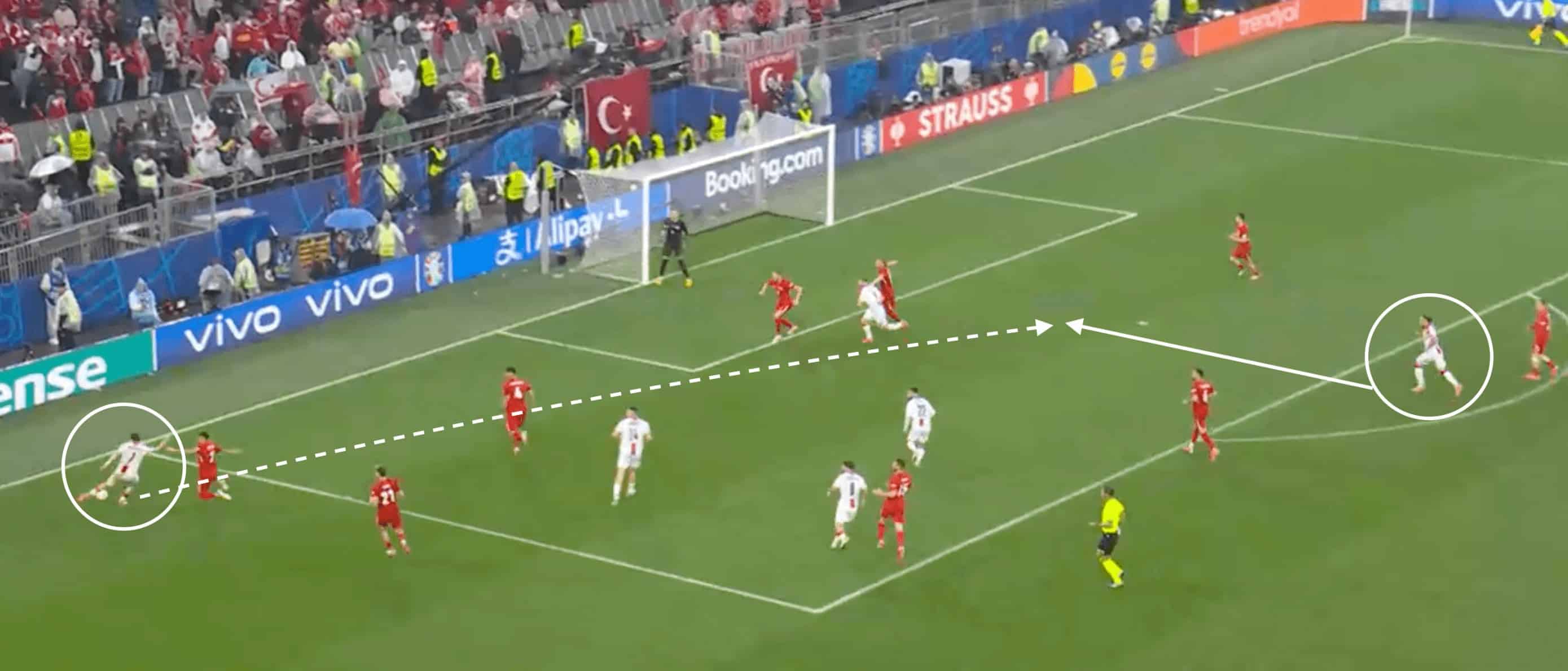
Their added vulnerability through the centre of the pitch was also highlighted by a smart one-two between Kochorashvili and Mikautadze.
The midfielder was able to penetrate the central channel before seeing his shot bounce off the crossbar.
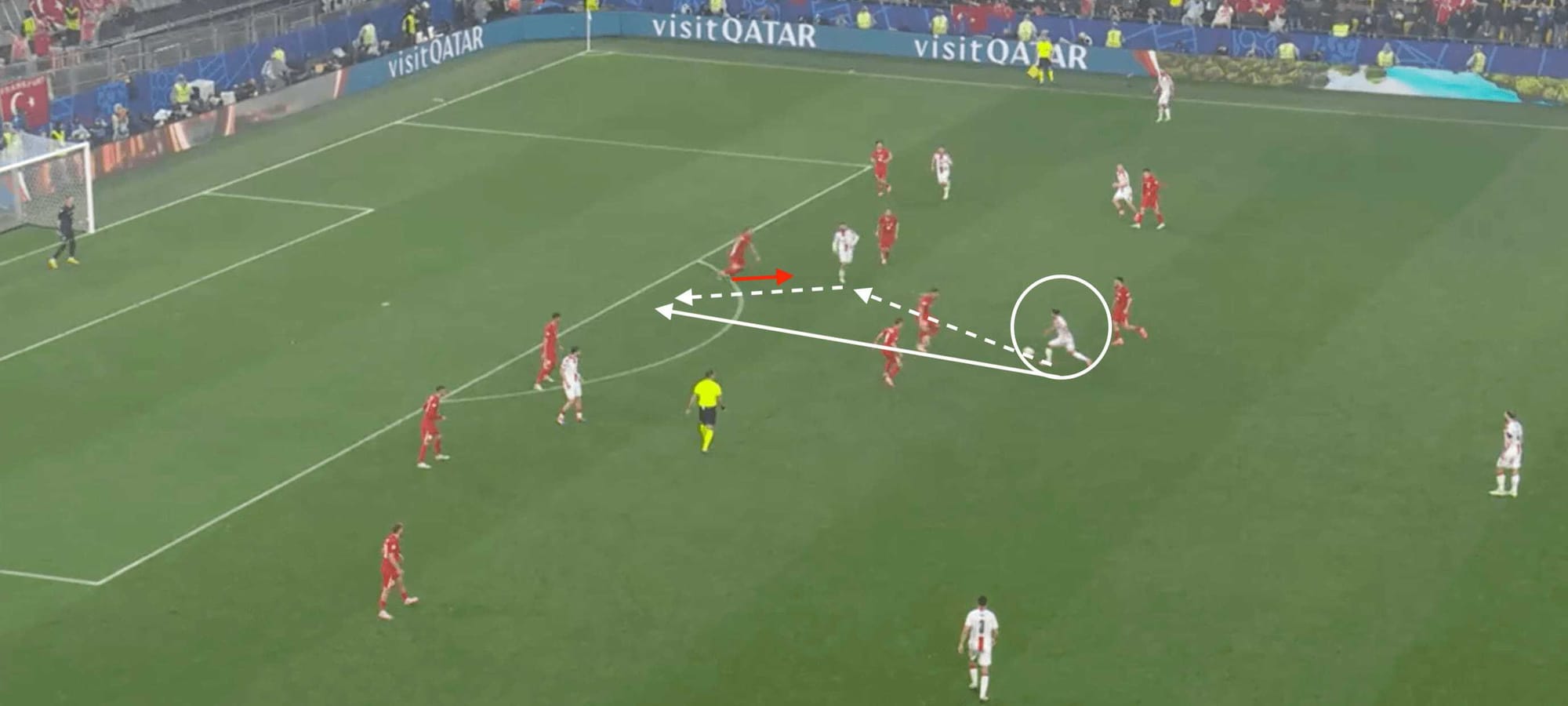
This weakness could potentially see Portugal be more effective on Saturday when lining up in the 4-3-3 formation, which has allowed them to be so prolific over the past 12 months.
The presence of a single pivot like João Palhinha would offer the necessary defensive cover and allow Bruno Fernandes and Vitinha to be more engaged in Portugal’s attacking sequences.
Against a Türkiye side that operates at a higher depth than Czechia, the frequency of turnovers and opportunities to attack space in behind will be much more prevalent, especially with the ball-winning characteristics that the Fulham man possesses.
Fernandes has consistently been a point of attack within this Portugal squad, displaying positive attacking intentions with his movement in transition, but was often required to remain deeper against Czechia.
One of the biggest chances for Portugal stemmed from Fernandes finding space on the right and flashing the ball across the face of the inverting Leão.
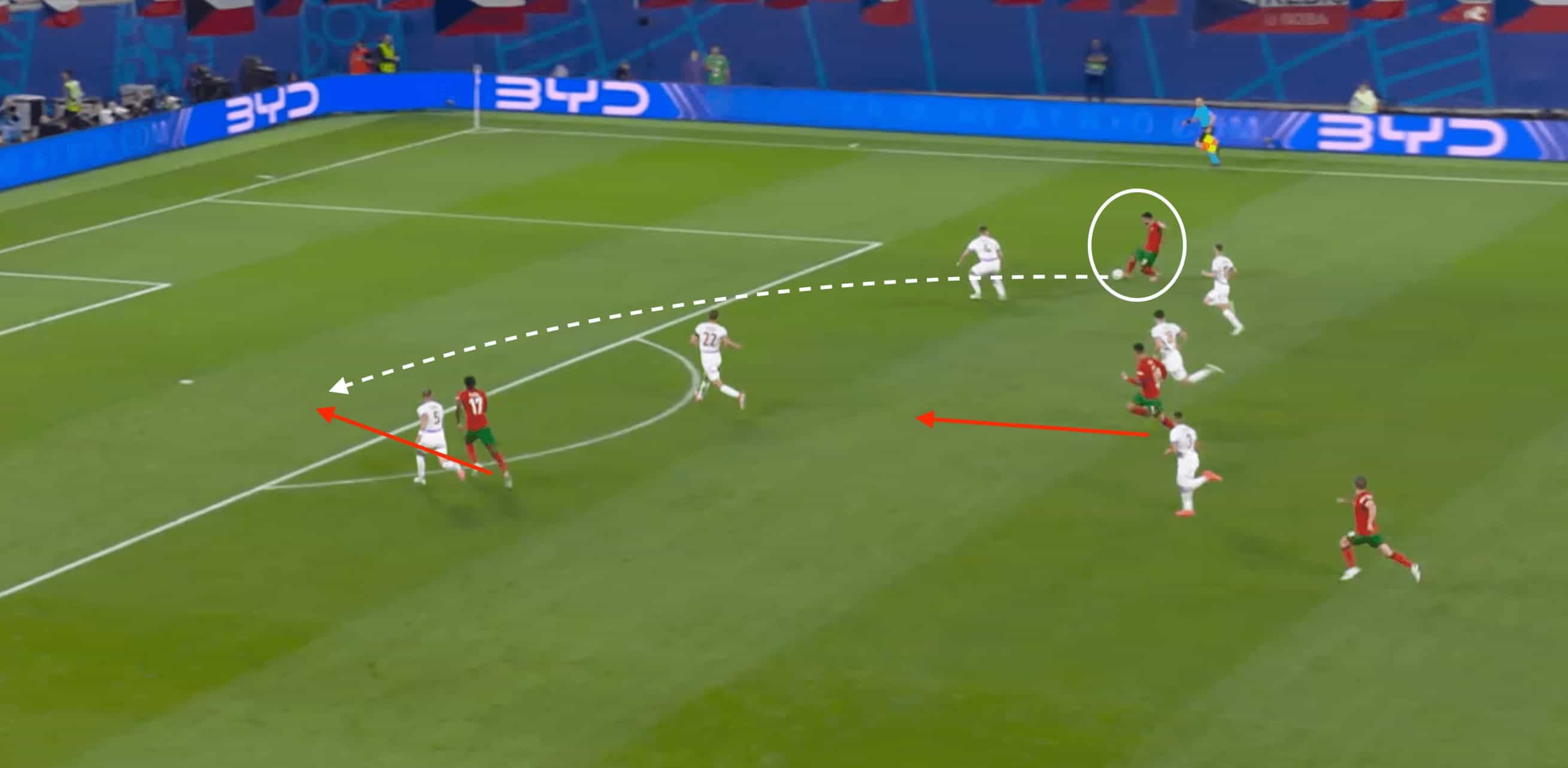
Should Martinez look to keep the tactical setup that found eventual victory in the opener, another interesting aspect to watch out for would be potential underlapping runs causing Türkiye issues through the half-spaces.
The wing-backs of Georgia found success when attacking the space created by their wider central midfielders, with Kakabadze combining nicely with Kochorashvili to break into the Türkiye penalty area.
The subsequent attacking move forced the Turkish central defenders to drift further apart and produce an excellent opportunity around the centre of the box.
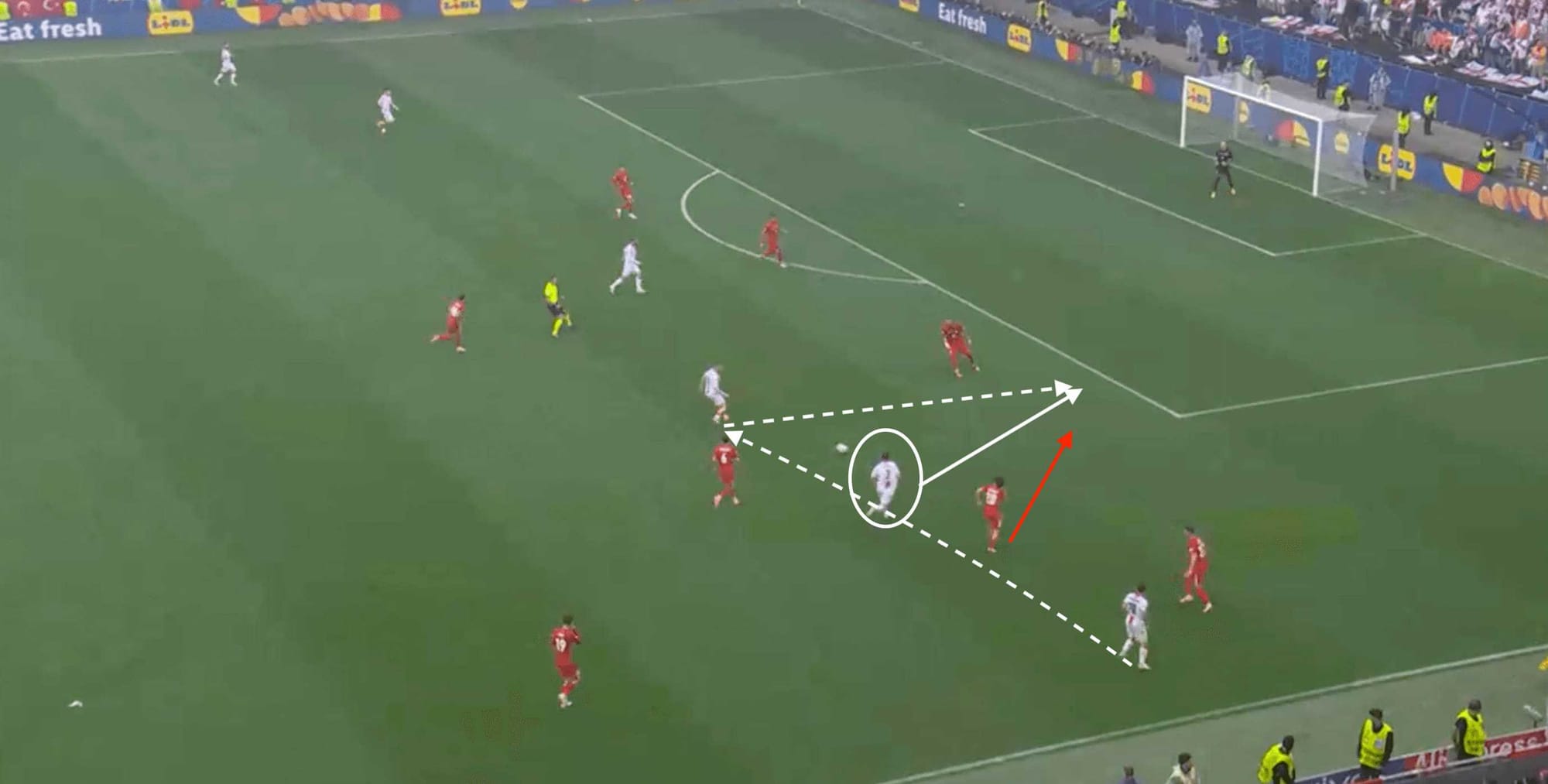
This poses an interesting question as to whether or not Cancelo could emulate such attacking movement rather than maintaining the central positioning we saw against Czechia.
Portugal looked much more dangerous with Jota through the half-spaces, and Cancelo’s movement would certainly give Portugal’s left winger more freedom to attack—whether that be Leão or the impressive Pedro Neto.
Conclusion
Portugal’s performance in the opening match emulated that of a few of this tournament’s favourites- grateful for the three points but needing tactical improvement should they want to end up as champions.
An uninspiring attacking performance was certainly not what many fans were expecting from this Portuguese side, but they will find confidence in the fact that their play was dominant in the other thirds of the pitch.
A fit and firing Cristiano Ronaldo will always capture the hearts of fans around the world, but his attacking desire must improve, along with Portugal’s ability to play closer together at the business end of the pitch.
We can expect Türkiye to provide more of an attacking test, but their desire to be progressive has its detriments in the defensive phase, with Portugal looking to put their stamp on Group F.

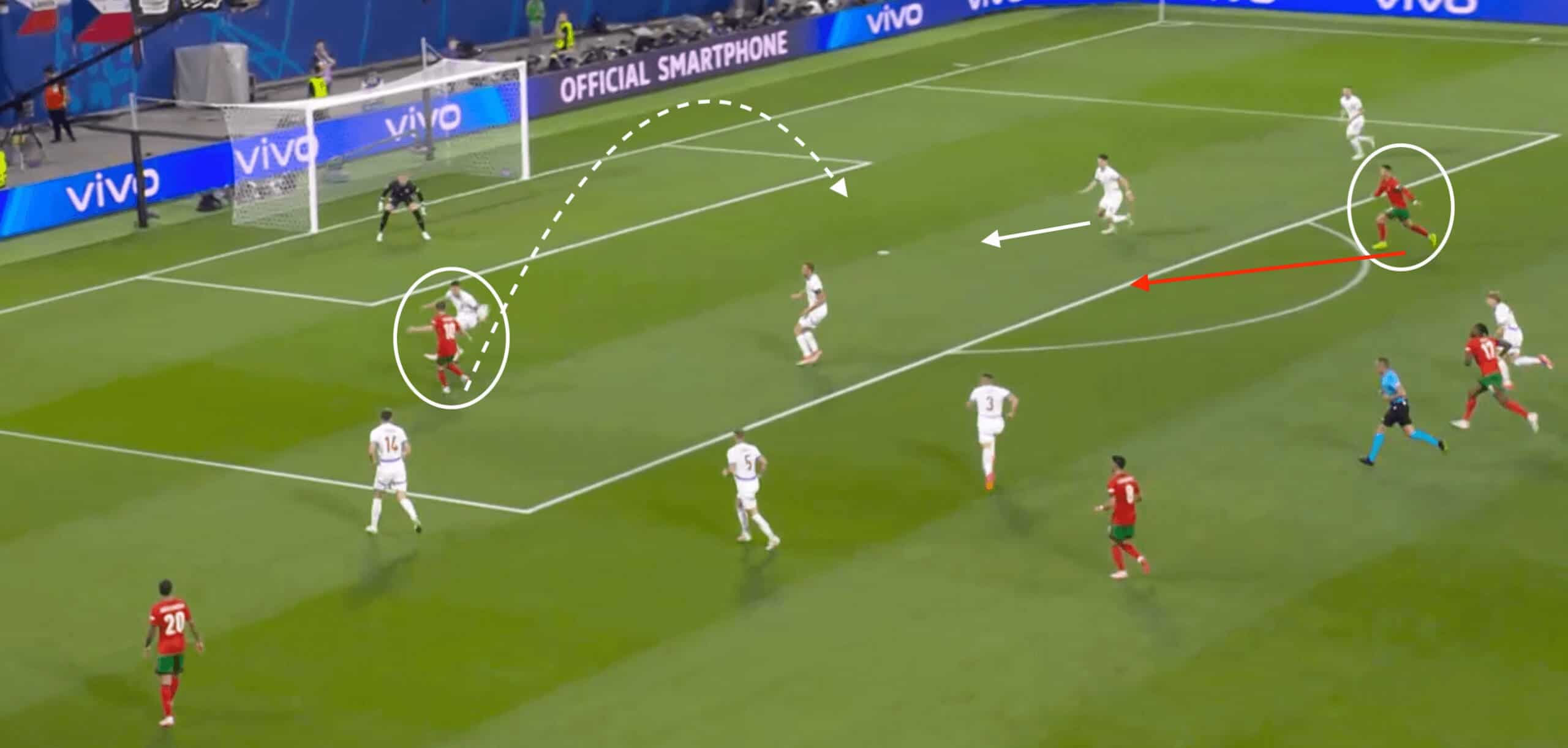



Comments